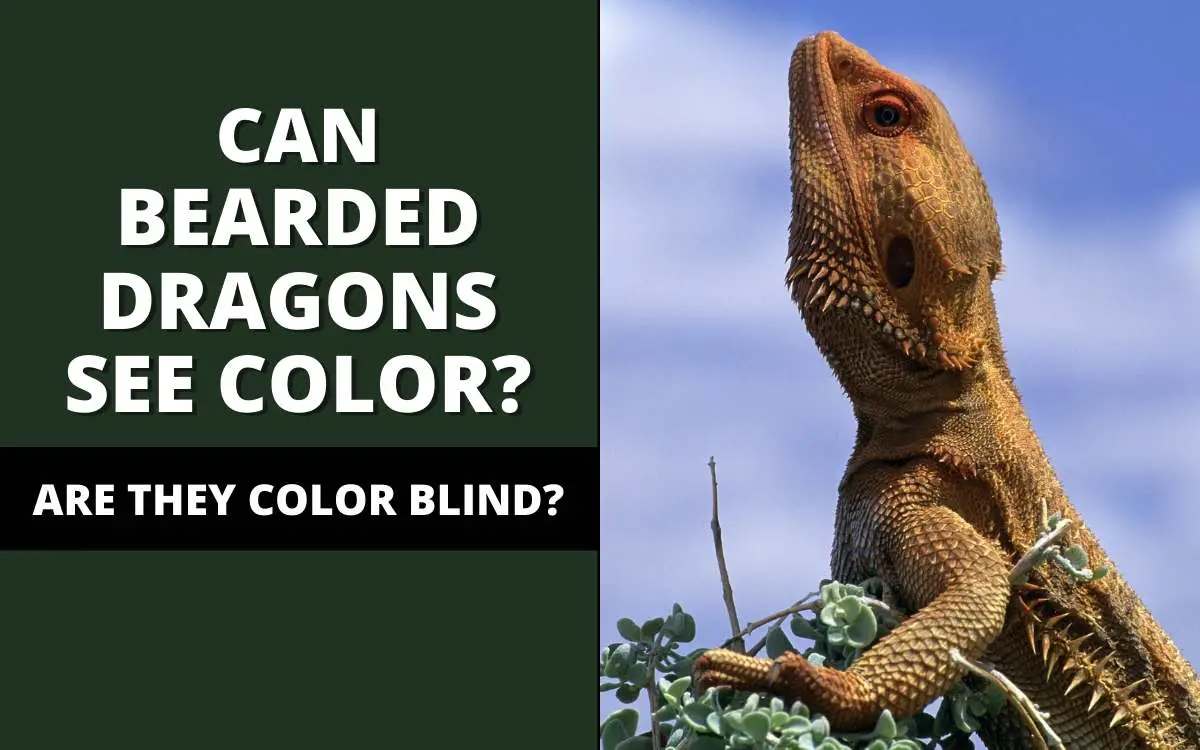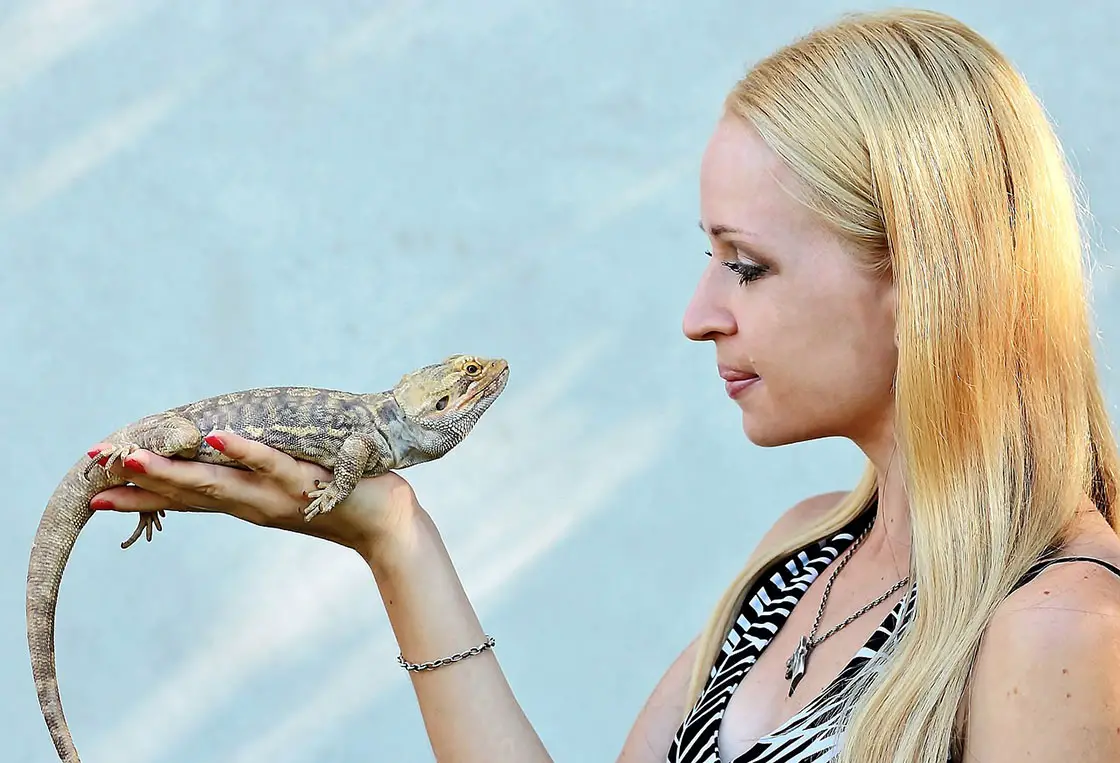Disclaimer: As an Amazon Associate I earn from qualifying purchases. Therefore, we may collect a share of sales from the links on this page, at no extra cost to you!

Pets are good companions for human well-being. However, curiosity about what they are, eat, how they see, and much more still exists. You may think you know your pet. However, every once in a while, a question will pop up in your mind about their nature.
Bearded dragon owners and admirers have their fair share of questions to ask, and one of them is if these dragons can see color.
Just like any other pet, bearded dragons depend on their sight to know what is around them. Their vision is clear, and they also see in color, and since they have eyes on the sides of their heads, their field vision is larger than that of the humans.
However, their depth perception is not that good. Therefore, bearded dragons time their leaps and bonk into things. Before you know and understand why bearded dragons can see color, it is vital to know how their vision works.
Jump to..
How Do Bearded Dragons See?
Knowing more about your bearded dragon likes and dislikes makes it easier for you to understand them and develop a stronger relationship. It is interesting to experiment with colors to experience what inspires them.
However, you should know that they see from two eyes at the sides of their head.
Bearded dragons also have a third eye, a grey spot located at the top of their head that only senses the change in light and shadows and not colors.
Their eyes are not positioned like human eyes. Human eyes are focused straight forward, meaning that we can only focus ahead and have slight peripheral vision up to the shoulders until we need to turn around.
On the other hand, bearded dragons can look forward and slightly over the shoulder, thanks to their eyes’ position.
Many pet owners are amazed by the cool and dazzling colors the bearded dragon possesses and displays.
There is a relationship between the colors bearded dragons like and the colors they display. The colors they display are more appealing to them.
They also change colors in reaction to different situations and conditions.
For example, when a beardie sees another changing color in its natural habitat, it will react by changing in response.
Color Association
Bearded dragons associate colors with different feelings and experiences. If they encountered a color in a situation where they felt in danger, they would be upset when they see it next time.
For instance, if your dragon had a bad past related to the color orange, it might get stressed out or irritated when it sees the color.
There are ways to know if your bearded dragon prefers a given color.
One is by closely observing them. You can dress in different colored t-shirts as you watch how they react.
You can also try giving them food to see its preferred plate color. Understanding your bearded dragon and its preferred colors will help you calm them down when they are stressed.
Are Bearded Dragons Color Blind?
Many people think that the bearded dragon is colorblind. The truth of the matter is, bearded dragons are not colorblind. These creatures have good vision in both eyes and can see more colors than humans.
Humans have three color receptors, while bearded dragons have four (tetra-chromatic). The fourth cone/receptor allows dragons to see UV light.
In most cases, they see brighter colors more than heavy and darker colors. If you observe keenly, you will notice that they tend to be more attracted to lighter-colored objects.
The only time that a bearded dragon can’t see color is in darkness. When in the dark, the bearded dragon’s vision is not so good.
Unlike cats in the dark, their pupils become inert. Night sight is not essential for these dragons because they are primarily active during the day and sleep at night.
Read More: Cat Proof Your Bearded Dragon Cage
What is the Value of a Bearded Dragon’s Sight?

After realizing that your bearded dragon can see even more colors than you, the next question you may have is why this vision is essential.
There are many reasons why bearded dragons need to see well, including:
Evading Predators
In the wild, it is all about survival. Bearded dragons in the wild use their good vision to evade predators. They can see ahead and behind them at the same time without necessarily moving their heads, making them fast enough when spotting predators.
Their third eye allows them to see whatever is overhead, for instance, a bird, enabling them to take appropriate action on time.
Finding Direction
Lizards, in general, are territorial. They occupy specific areas and always find their way back home if they leave their territories.
Lizards with a parietal eye, such as the bearded dragon, use it to find their way around. They can easily find their way home if they are lost, thanks to the third eye.
Detecting Time
As we mentioned earlier, bearded dragons are diurnal, meaning they sleep at night and are active during the day. Through their excellent eyesight, they can tell the time of day and predict when it will turn dark.
In captivity, you need to ensure that they have regular sleep times. If you turn on the lights at night, you will confuse your dragon that it is daytime.
Finding Prey
A good and wide range of vision is crucial for helping bearded dragons spot their prey in the wild.
In captivity, they need their vision to spot live feeders in the dragon tanks. They can easily catch the insects when they try to hide under rocks, on plants, and on substrate.
How Can You Help Your Bearded Dragon See Better?
Knowing the importance of your dragon’s vision, you need to ensure that their eyes stay in good condition. Below, we outline what you can do to help your dragon stay healthy.
Diet
Ensure that your dragon consumes meals with insects and vegetation. Such meals provide them with protein and vitamins, respectively. Ensure they get calcium and vitamin supplements.
Lighting
These dragons also need lighting. With the right basking temperature, they can digest the food and supplements that they have consumed. UVB lighting will help then absorb vitamin B3.
A combination of good lighting and a balanced diet is essential for their survival.
Final take
One of the main questions that bearded dragon enthusiasts have is whether these creatures have colored vision. They can see many colors, far beyond the number that human eyes can see. They also see better during the day and less at night. Ensure that you feed your bearded dragon a balanced diet and enough lighting to ensure that their eyesight is healthy.
